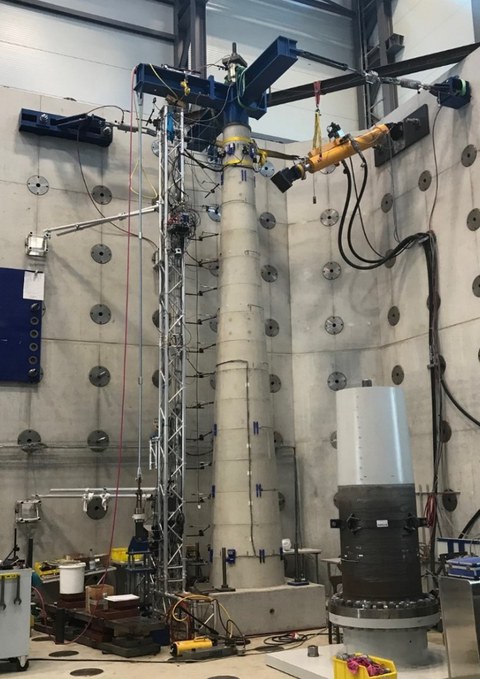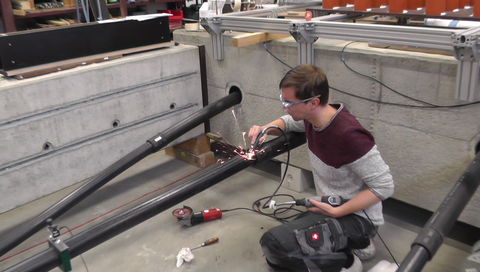Windenergieanlagen (WEA)
Inhaltsverzeichnis
- G - 19 Analyse von Dehnungen infolge Ermüdung mittels dFOS
- G - 18 Ermüdungswiderstand schubbeanspruchter trockener Betonfugen
- G - 16 Segmentierte Bauwerke unter Torsionsbeanspruchung
- G - 13 FE-Modell für Hybridtürme von WEA
- G - 12 Entwurf eines Resonanzversuchsstandes
- G - 11 Großformatige Versuche an segmentierten Betontürmen
- G - 5 Analyse von Spanndrahtbrüchen anhand von Schallemissionsmessungen
G - 19 Analyse von Dehnungen infolge Ermüdung mittels dFOS
Ausführlicher Titel: Analyse der Dehnungsentwicklung im Bauteilinneren infolge Ermüdungsbeanspruchung mittels faseroptischer Sensoren
Im Zuge des Ausbaus von erneuerbaren Energien spielen Windenergieanlagen eine zentrale Rolle. Nach aktuellem Bemessungsstand werden diese bisher jedoch nur für eine Lebensdauer von 25 Jahren ausgelegt. Für eine darüber hinausgehende sichere Nutzung der Anlagen ist eine Anpassung der Bemessungsgrundlagen erforderlich, die wiederum ein genaueres Verständnis der während der Nutzungsdauer auftretenden Veränderungen im Material notwendig machen.
Die Turmkonstruktionen von Windenergieanlagen werden durch Wind- und Wellenbelastungen biegebeansprucht. Dadurch stellen sich im Turmquerschnitt linear veränderliche Dehnungsgradienten ein. Durch diese ungleichmäßige Beanspruchung kommt es zu einer Materialdegradation der stärker beanspruchten Querschnittsbereiche und daraus folgend zu einer Spannungsumverteilung. Dieser Effekt wird am Institut für Massivbau in Versuchen an ermüdungsbeanspruchten Betonbalken näher untersucht. Um zusätzlich zu Messdaten an der Probekörperoberfläche Informationen über die Dehnungsentwicklung im Inneren des Probekörpers zu erlangen, wurden hierfür faseroptische Sensoren in die Betonbalken einbetoniert.
Im Rahmen dieser Arbeit sollen folgende Teilaufgaben bearbeitet werden:
- Literaturrecherche zum Ermüdungsverhalten von Betonbalken
- Literaturrecherche zur Dehnungsmessung mit faseroptischen Sensoren
- Begleitung des Aufbaus und der Durchführung der Balkenversuche
- Auswertung von faseroptischen Messdaten von Ermüdungsversuchen an Betonbalken
- Untersuchung der Dehnungsentwicklung im Inneren des Betons während der Ermüdungsbelastung
Ansprechperson:
Clara Schramm
0351 463 41117
G - 18 Ermüdungswiderstand schubbeanspruchter trockener Betonfugen
Die Betonsegmentbauweise ist bereits seit einigen Jahrzehnten eine etablierte Bauweise und findet vor allem im Segmentbrückenbau und in Turmkonstruktionen von hybriden Windenergieanlagen Anwendung. Durch die Vorfertigung der Segmente im Fertigteilwerk entstehen besonders im Vergleich zur Ortbetonbauweise zahlreiche Vorteile wie verkürzte Bauzeiten, eine höhere Bauteilqualität sowie die Realisierbarkeit von komplexeren Schalungsgeometrien. Die zwangsläufig zwischen den einzelnen Segmenten auftretenden Fugen werden häufig verklebt oder trocken ausgeführt. Dabei erfährt speziell die Ausbildung von Trockenfugen mit plan geschliffenen Bauteiloberflächen, d. h. ohne Anordnung einer Schubverzahnung, in den letzten Jahren eine wachsende Bedeutung. Dadurch wird ein vereinfachter Rückbau sowie eine Wiederverwendung der Segmente ermöglicht und somit ein Beitrag zum ressourcenschonenden und nachhaltigen Bauen geleistet.
In der Praxis ist die Ausführung von trockenen Betonsegmentfugen zwar bereits verbreitet, doch besonders das Tragverhalten derartiger Fugen unter zyklischen Beanspruchungen ist bisher we-der vollständig verstanden noch kann es zuverlässig modelliert werden. Um diesen Fragestellungen nachzugehen, werden am Institut für Massivbau statische und zyklische Reibversuche an Betonschubkörpern durchgeführt.
Im Rahmen dieser Arbeit sollen hierfür folgende Teilaufgaben bearbeitet werden:
- Literaturrecherche zum Reibverhalten trockener glatter Betonfugen unter zyklischer Belastung
- Begleitung des Aufbaus und der Durchführung der zyklischen Reibversuchen im Labor
- Auswertung von Messdaten von Ermüdungsversuchen an Betonschubkörpern
- Untersuchung des Reibverhaltens unter zyklischer Beanspruchung (Kraftübertragung in der Fuge, Temperaturentwicklung, Fugenverformung)
Ansprechperson:
Clara Schramm
0351 463 41117
G - 16 Segmentierte Bauwerke unter Torsionsbeanspruchung
Ausführlicher Titel: Tragverhalten von segmentierten Bauwerken im Brücken- und Ingenieurbau mit trockenen, geschliffenen Fugen unter Torsionsbeanspruchung
Innerhalb der kommenden 20 Jahre ist mit einem Austausch von über 50 % der bestehenden Brücken des deutschen Autobahnnetzes durch Ersatzneubauten zu rechnen. Zur Erreichung der Ausbauziele im Bereich der erneuerbaren Energien ist die Errichtung einer steigenden Anzahl sowie leistungsstärkerer Windenergieanlagen unabdingbar. Um die gesetzten Ziele zu erreichen, ist neben den bewährten Bauverfahren auch die Anwendung neuer, innovativer konstruktiver Lösungsansätze erforderlich. Eine vielversprechende Lösung stellen Segmentfertigteilkonstruktionen dar, bei denen die Tragkonstruktionen in einzelne Segmente aufgeteilt werden. Diese Segmente werden in einem Betonfertigteilwerk hergestellt, auf der Baustelle zusammengesetzt und durch nachträgliche, oftmals externe Vorspannung miteinander form- und kraftschlüssig verbunden. Die Minimierung von Herstellungsschritten auf der Baustelle ermöglicht äußerst wirtschaftliche und schnelle Bauverfahren, weshalb diese Bauweise mittlerweile weltweit mit steigender Tendenz angewendet wird. In Deutschland hingegen konnte sich diese Bauweise wegen Bedenken bezüglich der Dauerhaftigkeit der Konstruktion aufgrund der entstehenden Fugen bisher nicht gänzlich etablieren. Die ökologische Sensibilisierung der Bauindustrie sowie die Weiterentwicklung im Bereich der Automatisierung und der Digitalisierung in der Betonfertigteilherstellung eröffnen neue Möglichkeiten für die modulare Segmentbauweise.
Die Bauweise ist durch die zwangsläufig entstehenden Fugen charakterisiert. Eine Weiterentwicklung in diesem Bereich stellt die Ausführung trockener Segmentfugen ohne Verzahnung dar. Die Lastübertragung der in der Fuge wirkenden Schubspannungen erfolgt hierbei ausschließlich über Reibung. Dabei hängt der Fugenschubwiderstand von der Höhe der externen Vorspannkraft in Kombination mit dem Reibungskoeffizienten der Oberfläche ab. Bei einer Beanspruchung des Querschnitts durch Torsion entstehen neben den typischen Schubspannungen nach St. Venant zusätzliche Normalspannungen, die mit den Normalspannungen infolge Vorspannung interagieren und somit einen direkten Einfluss auf die Tragfähigkeit der trockenen Fugen haben.
Im Rahmen dieser Arbeit sollen folgende Teilaufgaben bearbeitet werden:
- Literaturrecherche zur Segmentbauweise von Stahlbeton- und Spannbetonkonstruktionen
- Initiale Auseinandersetzung mit der Theorie der Wölbkrafttorsion
- Parameterstudien an ausgewählten typischen Querschnittsformen zur Ermittlung der Höhe der zusätzlichen Normalspannungen
- Verknüpfung der Berechnungsergebnisse mit dem Fugenwiderstandes
- Auswertung und Beurteilung der Berechnungsergebnisse
Ansprechpartner:
Max Götze, M.Sc.
0351 463 35606
G - 13 FE-Modell für Hybridtürme von WEA
Vollständiger Titel: Optimierung und Sensitivitätsanalyse eines FE-Modells für hybride Turmkonstruktionen von Windenergieanlagen
* nur in deutscher Sprache *
Windenergieanlagen (WEA) leisten schon heute den größten Anteil an der Stromerzeugung aus erneuerbaren Energien in Deutschland. Um die Leistungsfähigkeit von WEAweiter zu erhöhen, geht der Trend zu immer höheren Türmen und größeren Rotordurchmessern. Speziell für große Nabenhöhen haben sich sogenannte Hybridtürme erfolgreich etabliert. Dabei ist die Errichtung von Anlagen mit Gesamthöhen von 240 m und mehr keine Seltenheit.
Der obere Teil derartiger Türme wird aus mehreren Stahlsektionen zusammengesetzt, wohingegen der untere Teil aus Betonfertigteilen besteht. Die einzelnen Betonsegmente werden dabei üblicherweise nicht miteinander verklebt oder vermörtelt, sondern trocken übereinandergestapelt und mittels externer Spannglieder miteinander verspannt. Zusätzliche vertikale Fugen zerlegen die Betonsegmentringe in kleinere Komponenten, sodass Halb-, Drittel- oder Viertelschalen entstehen.
Die Zerlegung der Turmkonstruktion in einzelne Betonfertigteilsegmente führt jedoch zu einem komplexen Tragverhalten, dessen vollständiges Verständnis sowie zuverlässige Modellierung bisher nicht möglich sind. Im Rahmen dieser Arbeit sollen folgende Teilaufgaben bearbeitet werden:
- Literaturrecherche zu Turmkonstruktionen von WEA und externer Vorspannung
- Erweiterung und Validierung eines bestehenden FE-Modells
- Sensitivitätsanalyse des Modells unter realistischen Randbedingungen
Ansprechpartner:
Max Götze, M.Sc.
0351 463 35606
G - 12 Entwurf eines Resonanzversuchsstandes
Vollständiger Titel: Entwurf eines Resonanzversuchsstandes als Rahmenschwingsystem
Um die zukünftige Forschung an Turmkonstruktionen von Windenergieanlagen (WEA) weiter voranzutreiben, sind insbesondere Kenntnisse über das Ermüdungsverhalten von großer Bedeutung. Die zyklische Beanspruchung aus Wind- und Wellenbelastung führt zu hohen Lastwechselzahlen im Laufe der Anlagenlebensdauer. Um die Ermüdungsbeanspruchung von Windenergieanlagen experimentell gut abzubilden, sind großmaßstäbliche zyklische Versuche an Tragstrukturelementen erforderlich.
Hierfür müssen die hohen Lastwechselzahlen und große Beanspruchungskräfte realisiert werden. Die Resonanzprüfmethode ist eine effiziente Möglichkeit zur Aufbringung der erforderlichen zyklischen Belastung. Zwei gegenläufige Unwuchtmotoren dienen zur Krafterzeugung. Die Erregerfrequenz der Motoren liegt hierbei nahe der Eigenfrequenz des Systems. Somit kommt es zur Resonanz und infolgedessen zur dynamischen Vergrößerung der Kräfte. Um die vorhandene Energie im System möglichst erhalten zu können, ohne dass immer mehr Energie hinzugefügt wird, sind Dämpfungs- und Reibungsmechanismen zu reduzieren. Damit die Energiedissipation minimiert werden kann, könnte ein geschlossener Rahmen als mechanisches System für einen Resonanzversuchsstand geeignet sein.
Im Rahmen der Arbeit soll ein Entwurf für ein Rahmenschwingsystem als Resonanzversuchsstands erarbeitet werden. Zunächst erfolgt das Einarbeiten in die Resonanzprüfmethode und Rahmenschwingsysteme. Anschließend werden zwei oder drei Entwürfe ausgearbeitet, aus denen dann ein Entwurf ausgewählt wird. Dieser wird unter vorgegebenen Randbedingungen näher betrachtet. Hierfür wird ein einfaches numerischen Modell erstellt mithilfe dessen das Schwingungsverhalten analysiert und die Bauteile dimensioniert werden.
Entsprechend der Interessen und des Kenntnisstandes der Studierenden wird die Aufgabenstellung gemeinsam formuliert.
Ansprechpartnerin:
Dipl.-Ing. Clara Schramm
0351 463 41117
G - 11 Großformatige Versuche an segmentierten Betontürmen
Vollständiger Titel: Großformatige Turmversuche zum Tragverhalten von segmentierten Betontürmen von Windenergieanlagen

Großformatiger Versuch zum Tragverhalten von segmentierten Betontürmen von Windenergieanlagen
Windenergieanlagen (WEA) leisten schon heute den größten Anteil an der Stromerzeugung aus erneuerbaren Energien in Deutschland. Um die Leistungsfähigkeit von WEA weiter zu erhöhen, geht der Trend zu immer höheren Türmen und größeren Rotordurchmessern. Speziell für große Nabenhöhen haben sich sogenannte Hybridtürme erfolgreich etabliert. Der obere Teil derartiger Türme wird aus mehreren Stahlsektionen zusammengesetzt, wohingegen der untere Teil aus vorgespannten Betonfertigteilringen besteht. Die einzelnen Betonsegmente werden dabei üblicherweise nicht miteinander verklebt oder vermörtelt, sondern trocken übereinandergestapelt und mittels externer Spannglieder miteinander verspannt.
Weit mehr als die Hälfte aller neu errichteten Windenergieanlagen werden in dieser Bauweise hergestellt. Dabei ist die Errichtung von Anlagen mit Gesamthöhen von 240 m und mehr keine Seltenheit. Trotz der großen praktischen Relevanz ist das komplexe Tragverhalten von derartigen Betontürmen mit trockenen Fugen bisher weder vollständig verstanden noch kann es zuverlässig modelliert werden. Daher werden am Institut für Massivbau großformatige Versuche mit Modelltürmen im Maßstab von ca. 1:10 durchgeführt. Ziel der Versuche ist es, das reale Tragverhalten von derartigen Türmen zu erfassen und darauf basierend Berechnungsmodelle zu entwickeln. Im Rahmen der Arbeit soll eine detaillierte Auseinandersetzung mit derartigen Turmkonstruktionen und den Turmversuchen erfolgen. Dabei sind speziell die folgenden Punkte zu bearbeiten:
- Literaturrecherche zu Turmkonstruktionen von Windenergieanlagen und deren Tragverhalten
- Dokumentation und Unterstützung bei der Durchführung der Turmversuche
- Auswertung ausgewählter Versuchsergebnisse
- Vergleich der Versuchsergebnisse mit bestehenden Berechnungsmodellen
Ansprechpartner:
Dipl.-Ing. Florian Fürll
0351 463 32317
G - 5 Analyse von Spanndrahtbrüchen anhand von Schallemissionsmessungen
Die Schallemissionsanalyse (SEA) ist eine zerstörungsfreie Prüfmethode, welche anhand der Analyse der vom Bauwerk emittierten Schallwellen Rückschlüsse auf eine Zustandsänderung des Bauwerks schließen kann. Eine Anwendung der SEA kann u. a. in der Bauwerksüberwachung, Detektion und Lokalisierung von Spanndrahtbrüchen und Materialforschung gefunden werden. Am IMB der TUD wird erforscht, mögliche Drahtbrüche der Spannglieder in Windenergieanlagen anhand SEA zu detektieren und lokalisieren.

Trennung eines Spannglieds mittels Dremel
Um reale Randbedingungen der Windenergieanlagen auch bei Laborversuchen zu bilden, wurde ein Spannrahmen mit den Maßen von 12 m × 4 m aufgebaut, wo insgesamt vier Spannglieder jeweils mit einer Länge von ca. 10 m vorgespannt wurden. Die verbauten Spannglieder wurden künstlich mit Hilfe von Dremel durchtrennt. Die dadurch erzeugten akustischen Signale wurden von den Schallemissionssensoren gemessen, welche verteilt im Spannrahmen platziert wurden. Das beigefügte Bild zeigt beispielsweise den Trennungsprozess eines Spannglieds im Spannrahmen und die verwendete Messtechnik.
Die gemessenen Signale weisen verschiedene Charakteristiken des Ausbreitungswegs vom Bruchort des Spannglieds bis zum Messsensor und sollen bezüglich der Ausbreitungsverhältnisse analysiert werden. Bei der Analyse der Signale wird zwischen der qualitativen und quantitativen Auswertung unterschieden. Bei der vorderen werden einige Schallemissionsfeatures wie Peakamplitude oder Signalenergie extrahiert und statistisch ausgewertet. Bei der letzteren werden die ganzen transienten Wellenformen der Signale betrachtet und sowohl im Zeit- als auch im Frequenzbereich ausgewertet.
Je nach den Interessen der/des Studierenden und der Art der studentischen Arbeit kann der Arbeitsumfang individuell angepasst werden. Für eine Diplomarbeit sind Kenntnisse über Programmierung in Python oder Matlab vorausgesetzt. Eine detaillierte Aufgabenstellung wird dementsprechend ausgearbeitet.
Ansprechpartner:
Dipl.-Ing. Ronghua Xu
0351 463 33776
